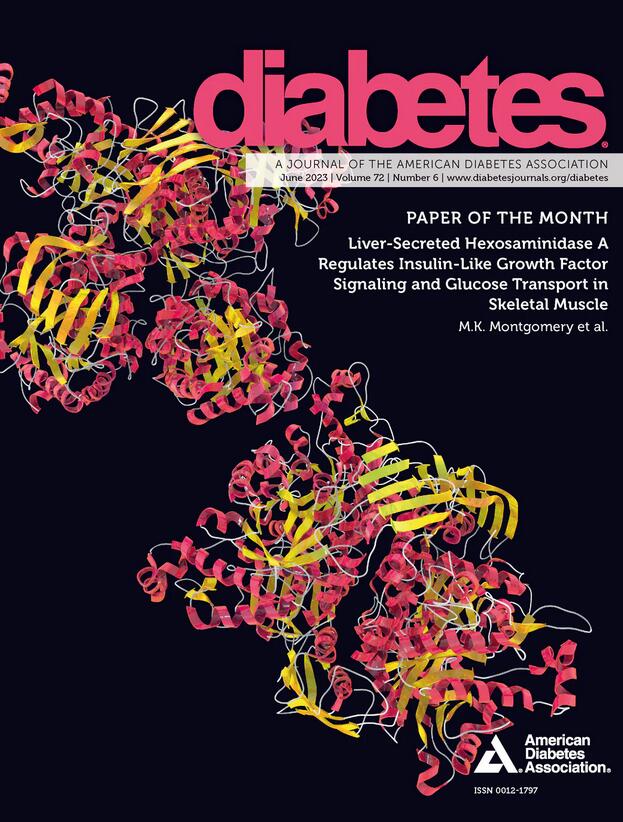1910-LB: Effects of a 6-Month Lifestyle Intervention for Type 2 Diabetes Featuring Intermittent Energy Restriction or Time-Restricted Eating on Glucose Tolerance and Body Weight
IF 7.5
1区 医学
Q1 ENDOCRINOLOGY & METABOLISM
引用次数: 0
Abstract
Introduction and Objective: Intermittent energy restriction (IER) and time-restricted eating (TRE) are forms of intermittent fasting which produce clinically relevant weight loss and improve metabolic health. However, the two approaches have not been tested in parallel and few trials have tested these interventions in patients with type 2 diabetes (T2D). We hypothesized that both interventions would be feasible, significantly improve glycemia, and reduce body weight. Methods: This RCT enrolled 57 adults (21-65 years) with type 2 diabetes (HbA1c 6.7-9.5%) and overweight/obesity (BMI 25-45 kg/m²) to participate in a 6-month, comprehensive diabetes education intervention featuring IER or TRE with energy restriction (TRE+ER). TRE+ER adhered to a ≤8-hour eating window as often as possible or ≥5 days/week and also reduced energy intake during months 0 - 3. IER utilized 2-3 very low-calorie diet (VLCD) days/week during the weight loss phase (0 - 3 months) and as often as needed to maintain weight during the weight maintenance phase (3 - 6 months). The intervention included regular group meetings to facilitate behavior change, and individual medical monitoring visits. Assessments were conducted at baseline, 3, and 6 months, including anthropometric measures, HbA1c, and glucose area under the curve (AUC) in a mixed meal tolerance test. Results: Retention was 87% in IER and 93% in TRE+ER at 6 months, indicating feasibility. After 6 months, TRE+ER reduced HbA1c by -0.5% (-0.8, -0.1), glucose AUC by 61 mg*h/dL (-108, -13), and body weight by 8.1 kg (-10.8, -5.5). Similarly, IER reduced HbA1c by 0.6% (-0.9, -0.3), glucose AUC by 65 mg*h/dL (-100, -31), and reduced body weight by 6.9 kg (-9.6, -4.2). There were no differences between groups. Conclusion: TRE+ER and IER both led to statistically significant and clinically relevant improvements in HbA1c, glucose AUC, and body weight. Future studies should compare these strategies to standard-of-care diabetes education and treatment. Disclosure F. Steger: None. K. Grdinovac: Consultant; AmalgamRx. J. Donnelly: None. C.K. Martin: Advisory Panel; EHE Health, Wondr Health. Other Relationship; Academy of Nutrition and Dietetics, ABGIL. Research Support; Foundation for Food and Agriculture Research; Kroger Co. Zero Hunger / Zero Waste Foundation, Weight Watchers International, Eli Lilly and Company. Other Relationship; The Bray Course Planning Committee, Spoonified. J. Miles: None. R. Montgomery: None. L. Clark: None. J.P. Thyfault: None. Funding American Diabetes Association (7-22-JDFN-13); National Institutes of Health (5P20GM144269)1910-LB: 6个月生活方式干预2型糖尿病间歇性能量限制或限时饮食对葡萄糖耐量和体重的影响
简介和目的:间歇性能量限制(IER)和限时进食(TRE)是间歇性禁食的两种形式,可产生临床相关的体重减轻和改善代谢健康。然而,这两种方法尚未进行平行试验,并且很少有试验在2型糖尿病(T2D)患者中测试这些干预措施。我们假设这两种干预措施都是可行的,可以显著改善血糖,降低体重。方法:该随机对照试验招募了57名(21-65岁)患有2型糖尿病(HbA1c 6.7-9.5%)和超重/肥胖(BMI 25-45 kg/m²)的成年人(21-65岁),参加了为期6个月的综合糖尿病教育干预,以IER或TRE加能量限制(TRE+ER)为特征。TRE+ER尽可能多地坚持≤8小时或≥5天/周的进食窗口,并在0 - 3个月期间减少能量摄入。在减肥阶段(0 -3个月),IER每周使用2-3天的极低热量饮食(VLCD),并在体重维持阶段(3 - 6个月)根据需要经常保持体重。干预措施包括定期举行小组会议以促进行为改变,以及个人医疗监测访问。在基线、3个月和6个月进行评估,包括人体测量、糖化血红蛋白和混合膳食耐量试验中的葡萄糖曲线下面积(AUC)。结果:6个月时,IER组固位率为87%,TRE+ER组固位率为93%,具有可行性。6个月后,TRE+ER使HbA1c降低-0.5%(-0.8,-0.1),葡萄糖AUC降低61 mg*h/dL(-108, -13),体重降低8.1 kg(-10.8, -5.5)。同样,IER使HbA1c降低0.6%(-0.9,-0.3),葡萄糖AUC降低65 mg*h/dL(-100, -31),体重降低6.9 kg(-9.6, -4.2)。两组之间没有差异。结论:TRE+ER和IER均能显著改善HbA1c、葡萄糖AUC和体重,且具有统计学意义和临床意义。未来的研究应该将这些策略与标准护理糖尿病教育和治疗进行比较。F. Steger:没有。K. Grdinovac:顾问;AmalgamRx。J.唐纳利:没有。C.K. Martin:咨询小组;EHE Health, wonder Health。其他关系;美国营养与饮食学会。研究支持;粮食和农业研究基金会;克罗格公司,零饥饿/零浪费基金会,慧俪轻体国际,礼来公司。其他关系;布雷课程规划委员会。J.迈尔斯:没有。蒙哥马利:没有。克拉克:没有。j·p·蒂夫斯克:没有。资助美国糖尿病协会(7-22-JDFN-13);美国国立卫生研究院(5P20GM144269)
本文章由计算机程序翻译,如有差异,请以英文原文为准。
求助全文
约1分钟内获得全文
求助全文
来源期刊

Diabetes
医学-内分泌学与代谢
CiteScore
12.50
自引率
2.60%
发文量
1968
审稿时长
1 months
期刊介绍:
Diabetes is a scientific journal that publishes original research exploring the physiological and pathophysiological aspects of diabetes mellitus. We encourage submissions of manuscripts pertaining to laboratory, animal, or human research, covering a wide range of topics. Our primary focus is on investigative reports investigating various aspects such as the development and progression of diabetes, along with its associated complications. We also welcome studies delving into normal and pathological pancreatic islet function and intermediary metabolism, as well as exploring the mechanisms of drug and hormone action from a pharmacological perspective. Additionally, we encourage submissions that delve into the biochemical and molecular aspects of both normal and abnormal biological processes.
However, it is important to note that we do not publish studies relating to diabetes education or the application of accepted therapeutic and diagnostic approaches to patients with diabetes mellitus. Our aim is to provide a platform for research that contributes to advancing our understanding of the underlying mechanisms and processes of diabetes.
 求助内容:
求助内容: 应助结果提醒方式:
应助结果提醒方式:


